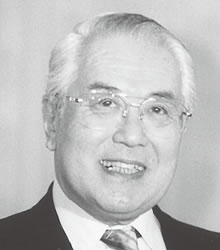2006年比較腫瘍学常陸宮賞受賞者
The Awardee of the 2006 Prince Hitachi Prize
for Comparative Oncology
"Studies on erythrophoroma cells of goldfish and its multiple differentiation"
魚類赤色腫の株細胞樹立と分化誘導
 松本二郎 博士
松本二郎 博士
慶応義塾大学名誉教授
Professor Dr. Jiro Matsumoto
Emeritus Professor, Keio University
略歴
松本博士は1932年1月12日に東京に生まれた。都立の中学校時代に、熱心な生物の教師に出会い、高校までの6年間を生物クラブで昆虫観察などで過ごしたことが、生物学にすすむ素地となった。東京教育大学理学部動物学科在学中(1952〜1955年)に、慶応大医学部の塚田祐三博士のヤリイカの研究を手伝ったのが切っ掛けで神経化学に興味をもち、卒業後、この教室で生理学を学んだ。その後、慶応大学の教養過程に移り、波磨忠雄博士のすすめる色素細胞の発生学の研究に参加した。
博士は、1957年に慶応大学教養過程の助手に採用され、1966年助教授、1971年教授となり1997年に定年退職された。この間、一貫して魚類の色素細胞の生理化学的研究に従事し、鯉科魚類色素細胞の色素形成とプテリヂンの役割に関する論文で理学の学位を取得した。
1976年に、博士は常陸宮殿下から、キンギョ皮膚に発現した赤色腫瘤の細胞学的性状につき質問を頂いたのを契機に、癌研究所実験病理で高山昭三、石川隆俊両博士とともに、この腫瘍の研究に従事した。腫瘍は赤色素胞に特徴的な性状をもつことから赤色腫(エリスロフォローマ)と命名された。赤色腫から数株の株細胞が樹立されたことで、in vitroでの分化誘導実験が可能となり、この細胞は分化誘導によりクローン単位で神経冠起源の多様な形質を発現することから神経冠幹細胞腫と呼べる性状を持つことが解明された。この外に、博士はチロジナーゼ遺伝子の導入による緋メダカの黒化、養殖ヒラメの色素異常の改善などの研究にも携わった。
この間、博士は米国で、J. T. バグナラ教授(アリゾナ大学、1968-1969年)、T. フィツパトリツク教授(ハーバアド大、1969-1970年)および、T. T. チェン教授(ウエイン州立大、1981年〜1982年)に師事し、国内では癌研究所嘱託研究員(1978〜1987年;1981年を除く)、Pigment Cell Research 編集主幹(1996〜1999年)、日本色素細胞学会会長(1998〜2000年)を兼務された。また、博士は福沢賞(慶応義塾、1969年)、清寺賞(日本リデアオリリー協会、1985年)、M・ゴードン賞(国際色素細胞学会連合、1996年)を受賞された。
Outline of Personal History
Dr. Matsumoto was born in Tokyo in January 12 1932. The encounter with a unique biology teacher in the high school who inspired interests for science triggered his inclination toward biological sciences. While studying in the Department of Zoology, Faculty of Science, Tokyo University of Education, he happened to join the research on giant axons run by Dr. Yuzo Tsukada of Keio University, School of Medicine, and was strongly interested in neurophysiology. After graduation, he studied it furher at Dr. Tsukada' department. In 1976, he was appointed as the assistant in the College of Arts and Sciences in Keio, and participated with the group there working on pigment cell development. He first engaged in the studies on the role of pteridines present in brightly colored pigment cells of lower vertebrates. Since melanogenesis and subsequent depositon of its products in mammalian melanocytes were specifically restricted to the melanosomes, it was expected to find out the counterpart of melanosomes in bright-colored pigment cells.
He succeeded in finding such an organelle and named the pterinosomes. Based on this finding, he proposed, together with Dr. J. T. Bagnara, the concept on the common origin of pigment cells.
In 1976, he had the honor of being asked from Prince Masahito about orange-colord skin tumors occurring in the goldfish skin, particularly with respect to their characterization as a pigment cell tumor. Thus, the studies on these tumors were started in the Department of Experimental Pathology, Cancer Research Institute under collaboration with the Majesty, Drs. S. Takayama and T. Ishikawa. They successfully disclosed that these tumors were of erythro- or xanthophore origin, being named erythrophoromas, and that permanent cell lines established from them were able to express, on a clonal basis by induction of differentiation, a variety of characters specific to the progeny of the neural crest. From these findings, these tumors were considered to be a neural crest stem cell tumor in nature.
After being recriuted in Keio University, he was promoted to an associate professor in 1966, a professor in 1971, and retired with the title of the emeritus professor in 1997. In the meantime, he worked as a visiting research fellow or professor in the University of Arizona (1968-1969), Harvard Medical School (1969-1970), Cancer Research Institute (1978-1987, except 1981) and Wayne State University (1981-1982). He also served as the Editor-in-Chief for Pigment Cell Research (1996-1999) and the President of the Japanese Society for Pigment Cell Research (1998-2000). He was awarded the Fukuzawa Prize from Keio (1969), the Seiji Memorial Award from the Lydia 'O' Leary Memorial Foundation (1985) and the Myron Gordon Award from the International Federation of Pigment Cell Societies (1996).
研究業績
松本博士は、魚類皮膚色素細胞の微細構造を含む形態、生理化学的性状および発生学的起源に関する研究で多大な業績を挙げて来られた。それらは二つに分ける事が出来る。
第一は正常色素細胞を扱った研究で、成果は(1)赤〜黄色色素細胞にプテリジンと呼ばれる一群の分子種からなる色素が存在すること、(2)これらの色素はプテリノソームと命名されたこの表現型に固有の細胞内顆粒に局在していること、および(3)プテリノソームは小胞体・ゴルジー装置系を介して形成されることを解明したことに要約できる。
1960年代に、魚類・両生類の赤〜黄色色素細胞にプテリジンと呼ばれる色素が存在することが注目され始め、その同定や生理学機能の解明に多くの関心が寄せられた。この時期には、哺乳類メラノサイトでは、清寺誠博士、T. フィツパトリツク教授らにより、メラニン色素が細胞内顆粒(メラノソーム)に局在することが確立されつつあったので、プテリノソームの発見は下等脊椎動物の赤〜黄色色素細胞にもメラノソームに相当する細胞装置が存在することを解明したことになる。この知見は、その後,下等脊椎動物に発現するモザイックな表現型を示す色素細胞の存在に補完されながら、脊椎動物色素細胞は共通の細胞機構を基礎に、多様な表現型を形成するとした色素細胞共通起源説の提起へと発展した。この系譜に属する研究では、博士はチロジナーゼ遺伝子の導入による緋メダカの黒化や養殖ヒラメの色素異常の改善などにも携わった。
第二は腫瘍性色素細胞に関するものである。1976年に、博士は常陸宮殿下から、キンギョ皮膚に発現した赤色腫瘤の細胞学的性状につき質問を受け、これを契機に、この腫瘍の共同研究が進められた。色素細胞の腫瘍は黒色腫(メラノーマ)で代表されるが、正常細胞の表現型が多型であれば、それに対応して腫瘍も多様であると推測される。キンギョに発現した赤色腫瘤は赤色素細胞固有の性状をもつことから、赤色腫(エリスロフォローマ)と命名され、メラノーマと異なる新しい色素性腫瘍の登場となった。この腫瘍から数株の株細胞が樹立されたことで、in vitroでの分化誘導が可能となり、この株細胞はクローン単位で,神経冠起源の多様な形質を同調的に発現することが明らかにされた。発現する形質にはメラニン色素の形成や神経細胞様の分枝した形状の発現、さらにはレンズ様構造や歯片様構造の形成などが含まれる。誘導により発現した黒色素胞様細胞には色素凝集反応性などの生理学的機能を獲得したものもあって、分化と増殖とのニ律背反性も観察された。これらの知見は赤色腫が神経冠幹細胞腫というべき性状を持つことを示していると考えられた。博士は正常色素細胞の研究から得られた知識を基礎に、赤色腫の研究を推進したが、その成果は、比較腫瘍学への重要な貢献である。
Academic Achievement
Dr. Jiro Matsumoto has made impressive achievements in ultrastructural and physico-chemical characterization and in elucidation of the developmental origin of fish skin pigment cells.
The first part of his studies was carried out with the use of normal pigment cells. He successfully disclosed (1) the ubiquitous distribution of pigments called pteridines in erythrophores or xanthophores, (2) the selective localization of these pteridines in a unique intracellular granule named pterinosome and (3) the formation of this organelle through endoplasmic reticulum and Golgi apparatus.
In 1960's, the occurrence of pteridines in the erythrophores or xanthophores of fish and amphibians had attracted much attention and the elucidation of their chemical structure and physiological functions became an exiting topic. Since the presence of melanin pigments in the melanosomes of mammalian melanocytes had then been established by Drs. M. Seiji and T. B. Fitzpatrick, the recognition of pterinosomes meant a discovery of the counterpart of melanosomes in lower vertebrates . This insight was complemented by the discovery of peculiar pigment cells with a mosaic phenotype and developed into the proposal of "common origin concept of pigment cells", assuming that all pigmentary phenotypes may be derived from a common stem cell in vertebrates. Dr. Matsumoto also participated in various studies inducing heritable melanogenesis in the orange-colored medaka fish and improvement of pigment anomaly occurring in the hatchery-raised flounders, by transfection of mouse tyrosinase gene.
The second part of Dr. Matsumoto's studies was concerned with neoplastic pigment cells. In 1976, he had the honor of being asked from Prince Masahito about the nature of pink skin tumors occurring in the goldfish. Thus, the collaborative stuides on these tumors started. Since the melanoma had been well-known as a tumor of melanocytes or melanophores, it was naturally expected to find tumors manifesting various colors in concert with the phenotypes of normal pigment cells. The pink tumors found in the goldfish was characterized as being of erythrophore or xanthophore origin, and was named erythrophoroma. Then Dr. Matsumoto succeeded in establishing permanent cell lines from those erythrophoromas. The cell lines manifested, on a clonal basis, a variety of characters such as melanogenesis, reflecting platelet formation, neuron-like extension of dendrites, lentoid body and teeth-like structure upon differentiation-inducing procedures. From these findings, these tumors were concluded to be neural crest stem cell origin. Some of melanogenic clones manifested an apparent pigmentary response which was specific to terminally differentiated melanophores. Since these clones were accompanied with greatly reduced proliferative activities, the alternative occurrence of differentiation and proliferation was clearly demonstrated.
Dr. Matsumoto has thus promoted the studies of goldfish erythrophoromas based on the knowledge gained through the studies on normal pigment cells. The results of these studies have contributed greatly to the development of the comparative oncology.

